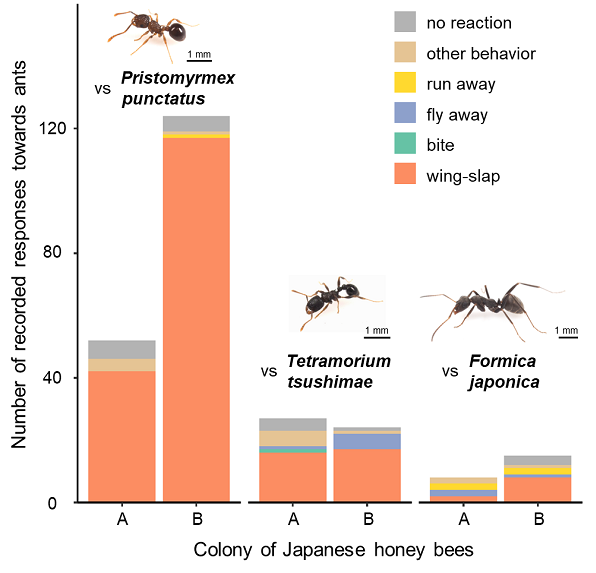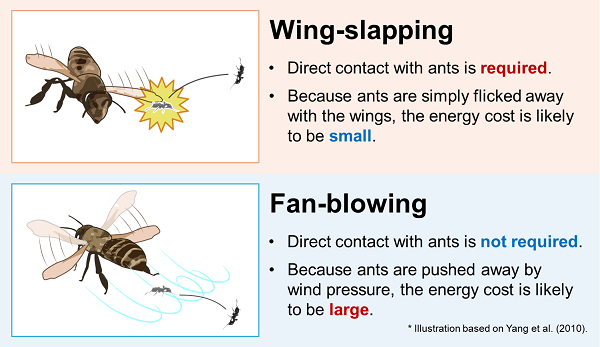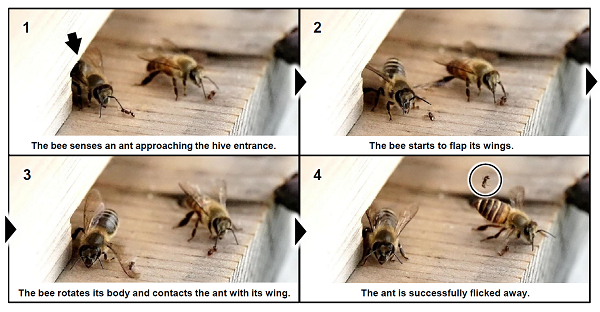Wing-slapping: A defensive behavior in which honey bees flick away ant intruders
The results were published in the July 9, 2024 issue of Ecology, an academic journal published by the Ecological Society of America.
Background
Beehives contain large stores of larvae, pupae, and honey, making them attractive food resources for natural enemies. Ants are one such enemy, and ant intrusions can sometimes cause devastating damage to honey bee colonies.
Previously, studies in other countries have shown that honey bees prevent the entry of ants by facing away from the ants and flapping their wings to drive the ants away with wind pressure. This behavior is referred to as “fan-blowing” and has been observed among honey bee species and subspecies in various regions. On the other hand, the Japanese honey bee (a subspecies of the eastern honey bee), which is endemic to Japan, engages in a different defensive behavior in which the bees flick ants away through direct contact with their wings. Although this behavior was known anecdotally among some beekeepers, there do not appear to have been any academic studies that have examined the ecological significance of the behavior based on detailed observation.
Results and Discussion
To closely observe the defensive behavior of Japanese honey bees against intruding ants, we trained a high-speed camera on worker bees as they responded to Japanese pavement ants approaching the hive entrance. The footage showed that the bees approached the ants and rotated their bodies while flapping their wings, thereby flicking the ants away (Figure 1). We named this behavior “wing-slapping.”
Next, to assess whether Japanese honey bees also perform wing-slapping on other ant species, we recorded the responses of Japanese honey bees to the introduction of three native ant species (Japanese queenless ant Pristomyrmex punctatus, Japanese pavement ant Tetramorium tsushimae, and Japanese wood ant Formica japonica) near the hive entrance. Wing-slapping was the behavior most frequently performed by Japanese honey bees in response to all three ant species (Figure 2). This suggests that wing-slapping is the main behavior used by Japanese honey bees to defend against intruding ants.

It is unclear at this time whether other varieties of honey bees perform wing-slapping behavior. However, our results, in combination with previous reports from around the world, indicate that various honey bee species and subspecies employ different behaviors to defend against ant intrusion, and we speculate that this difference could be related to differences in the risk of predation by ants (Figure 3). In regions where bees show fan-blowing behavior, the native ant species include so-called “aggressive ants” that approach hives to prey on adult bees. Therefore, fan blowing, in which the bee’s wings do not come into direct contact with the ants, is likely an effective means of reducing predation risk on the part of the bees, albeit at a high energy cost. On the other hand, in Japan, where wing-slapping behavior is prevalent, the risk of predation from ants is thought to be low because few native ant species actively prey on adult bees. We hypothesize that more energy-efficient wing-slapping behavior evolved in this region as an adaptation to the lower predation risk from ants.

Directions for Future Research
In this study, we showed that wing-slapping is the main behavior used by Japanese honey bees to defend against intruding ants, and developed a new hypothesis about the conditions under which this behavior might evolve. To test this hypothesis, more research is needed to identify the defensive behaviors of bees in various regions around the world in relation to the risk of predation by ants.
In addition, in recent years, many nonnative ant species have become established or even invasive in Japan, and the probability of contact between these species and Japanese honey bees is increasing each year. Eventually, there may come a time when Japanese honey bees will have to contend with nonnative ants that actively prey on adult bees. Wing-slapping is not expected to be effective against such ants because of the high risk of predation. In the future, we hope to do more to assess and predict the impacts of nonnative ants on honey bees, including from the perspective of defensive behavior.
There are many unknowns about wing-slapping, including which species in what regions perform the behavior. If you have any information about this behavior, please do not hesitate to contact us.
Article Information
Article title: Wing-slapping: A defensive behavior by honey bees against ants Authors: Yugo Seko*, Kiyohito Morii*, Yoshiko Sakamoto (National Institute for Environmental Studies, Biodiversity Division) *: Co-first authors Journal name: Ecology Publication date: July 9, 2024 URL: https://esajournals.onlinelibrary.wiley.com/doi/full/10.1002/ecy.4372 (a link to an external site) DOI: https://doi.org/10.1002/ecy.4372 (a link to an external site)
Research Funding
This research was funded by grants from JSPS KAKENHI (JP20H00425, JP23K13970, and JP23K13971).
Contact
Research inquiries
Kiyohito Morii, National Institute for Environmental Studies, Biodiversity Division, Ecological Risk Assessment and Control Section
Email: bee-project (please append @nies.go.jp to this address)
Press inquiries
National Institute for Environmental Studies, Planning Division, Public Relations Office
Email: kouhou0 (please append @nies.go.jp to this address)
- What's New
- What's New 2024
- What's New 2023
- What's New 2022
- What's New 2021
- What's New 2020
- What's New 2019
- What's New 2018
- What's New 2017
- What's New 2016
- What's New 2015
- What's New 2014
- What's New 2013
- What's New 2012
- What's New 2011
- What's New 2010
- What's New 2009
- What's New 2008
- What's New 2007
- What's New 2006
- What's New 2005
- What's New 2004
- What's New 2003
- What's New 2002
- Event Information
- Visit NIES
